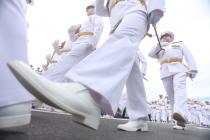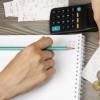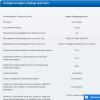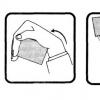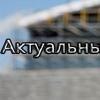Topic: Sounds "P - Pb". Phonetic story "Weed chickens"
Goal: development of conscious and expressive reading skills
Tasks:
- Correctional and educational: to expand children's ideas about birds.
- Correction-developing: to develop auditory perception, phonemic processes, voluntary attention, thinking; complete the dictionary.
- Correctional and educational: to cultivate interest in the word, the ability to evaluate their activities.
Equipment: presentation “Whose sound?”, subject pictures, cards for individual work, colored pencils
Lesson progress
I. Organizational moment.
Attention! Check
Are you ready to start the lesson.
Is everything in place, is everything in order -
Pen, pencil, notebook.
We will respond actively
To behave,
So that dear guests
Wanted to come back.
Speech therapist: - Guys, what day of the week is it today? Month? What winter month is this?
II. Main part.
1. Breathing exercises. The game "Whose sound?"
Speech therapist: - Guys, quietly sat down, closed their eyes and calmly breathed through their noses.
Speech therapist: - Now we take a deep breath through our nose, exhale through our mouth, stretching our lips with a tube. You are relaxing and your ears are listening attentively. (Presentation “Whose sound?”: sounds of a flying helicopter, thunder, sea, drum set)
Speech therapist: - Name the sounds that you heard.
Speech therapist: - Listen to the words: helicopter, thunder, sea, drum. What sounds when pronouncing did I highlight with my voice? (sounds "r", "r")
Speech therapist: - Today in the lesson we will work with the sounds "r", "r" and the letter "R"
2. Game "Replace the letter"
Speech therapist: - Words are printed on the board. Replace the highlighted letter in them with the letter "r" and read the new words.
Speech therapist: - Name the extra word in each column. Why do you think so?
(Superfluous word - growl, because it denotes an action, and the remaining words name objects; mouth, because the sound "r" is at the beginning of the word, and in the rest of the words in the middle)
3. Reporting the topic of the lesson.
Speech therapist: - Today in the lesson we will get acquainted with the phonetic story. The story is called phonetic because it contains many words with a certain sound. What do you think the sound is? (About the sound "R")
4. Game "Decoders"
Speech therapist: - Guys, in order to find out the name of the story, you must solve the cipher. Enter the missing letter in alphabetical order. Make up words from the given letters.
R. T, . P R, P. S, L M., Kommersant. b, G D.
J. L, . F Kh, O P., Shch b.
(weed chickens)
5. Work with syllabic tables.
Speech therapist: - Before you start reading the text, you need to train your speech apparatus. To do this, read the syllabary table.
- children read the table together in an undertone, “for themselves”;
- the game "LOTO" (the speech therapist reads the syllable, and the children find it and close it with a chip);
- the final stage of working with the table: children read aloud on the instructions of the speech therapist: the first column, the third line, diagonally, the fourth column
| KERs | GRA | Ryuku | OPOR | SECOND |
| RGIP | VITOR | AR | lynx | AZAR |
| ROCK | ORS | TRO | RALI | ORO |
| ACRE | RU | Ryu | ART | MEP |
| EP | TRAM | PRJ | OPE | CUT |
6. Physical Minute.
Speech therapist: - Let's have a rest.
From behind the desks we will go out together,
But there is no need to make noise.
Stand up straight, feet together
Turn around in place.
Clap your hands a couple of times
And let's dive in a little.
Now imagine, kids
As if our hands are branches.
Let's shake them together
Like a south wind is blowing.
The wind died down. They sighed together.
We need to continue the lesson.
7. Acquaintance with the phonetic story "Weed chickens"
Speech therapist: - Guys, listen to the story. If some words are incomprehensible to you, remember them. After reading, we will explain them.
weed chickens
It turns out that a simple chicken Ryaba has many different relatives in the world. Partridge, black grouse, and capercaillie also belong to chicken relatives. Even a small quail is a direct relative of a chicken.
All listed birds produce offspring in the same way. For many days in a row, they warm the eggs with their warmth.
But in Australia there are special, weed chickens. They arrange an interesting incubator: they rake various rubbish in a heap or bury their eggs in hot sea sand. In such an incubator, nimble chicks quickly appear, which on the very first day are taken to fly.
(Vocabulary: Ryaba and weeds - breeds (species) of chickens that have a certain color; incubator - a special place for breeding chicks v)
weed chickens
It turns out that a simple chicken Ryaba has many different relatives in the world.
Partridge, black grouse, and capercaillie also belong to chicken relatives.
Even a small quail is a direct relative of a chicken.
All listed birds produce offspring in the same way.
For many days in a row, they warm the eggs with their warmth.
But in Australia there are special, weed chickens.
They arrange an interesting incubator: they rake various rubbish in a heap or bury their eggs in hot sea sand.
Nimble chicks quickly appear in such an incubator, which take to flying on the very first day.
8. The game "True - False"
Speech therapist: - And now we will check how well you understood and remembered the text.
Read the sentences and if it is correct, put “+”, if it is incorrect “-“.
(Children read on their own, followed by checking and correcting errors)
9. Game "Find the word"
Speech therapist: - Read the adjectives. Find in the text who or what it says.
Little
Interesting
Hot
Nimble
(small quail, interesting incubator, hot sand, nimble chicks)
10. The game "The most attentive"
Speech therapist: - Find in the text two words with the letter "p" at the beginning and circle with a simple pencil.
Find two words with an "r" in the middle and underline them.
- Find two words with the letter "r" at the end and underline with a wavy line.
- Read the words.
Speech therapist: - Find in the text two words in which the sound "R" sounds soft and underline them with a green pencil; two words in which the sound "R" sounds hard and underline them with a blue pencil. Read the words.
III. Final part.
Speech therapist: - What was the name of the phonetic story that we were reading? What is the most common sound in words? What new word did you learn? Assess your mood with emotional cards. Choose a card that matches your mood.

Speech therapist: - The lesson is over. Thanks to all.
List of used literature:
1. Kalmykova I.R. The mysterious world of sounds. Phonetics and culture of speech in games and exercises. - Yaroslavl. "Academy of Development", 1988. - 240 p.
2. Tkachenko T.A. Phonetic stories with pictures. Sounds R - R. - M.: "ARKTI", 2004. - 33 p.
L.B. Ulyantseva - teacher-speech therapist GMPMPK, specialist of the highest qualification category;
E.B. Pletneva - teacher-speech therapist of the highest qualification category, methodologist of the highest qualification category
EXPLANATORY NOTE
The educational (correctional and developmental) program was developed in order to provide speech therapy assistance to primary school students who have mild dyslexia and experience difficulties in developing reading skills. The program is based on an understanding of the complex psycho-physiological structure of the reading process in the norm and the peculiarities of mastering this skill by children and is compiled in accordance with the state standard for reading in elementary school and in accordance with the definition of dyslexia in modern correctional pedagogy. The program reflects scientific data on the theory and methodology of correctional work, as well as achievements in the field of psychology, psycholinguistics, speech therapy.
The theoretical basis of the program is the provisions on the relationship between correction and development, developed by L.S. Vygotsky, P.Ya. Galperin, D.B. Elkonin.
The program also reflects the ideas of a number of scientists (R.I. Lalayeva, L.G. Paramonova, L.N. Efimenkova) on the problems of formation and overcoming of violations of the reading process in children.
When compiling the curriculum, the following were used:
Systems of correctional work at the phonetic, lexical and syntactic levels, proposed in the works of I. N. Sadovnikova, V. I. Gorodilova, M. 3. Kudryavtseva, L. N. Efimenkova, G. Misirenko;
The system for working with syllabic tables proposed by A. N. Kornev;
The system of psychological exercises and tasks proposed by S. N. Kostromina and L. G. Nagaeva;
The system of tasks aimed at improving diction and expressiveness of reading, proposed by T. I. Kondranina and L. M. Kozyreva.
When compiling the program, the experience of the work of speech therapists of the GMPMPK with younger students on the problems of developing reading skills was also used.
The programs involve determining the topics of the content of correctional and developmental classes in order to obtain positive dynamics in the correction of the reading process; selection and systematization of material for the development of correctional and developmental classes; determination of the range of issues of competence of a speech therapist teacher when conducting consulting and methodological work with parents and specialists of educational institutions.
The program is designed to work with children of primary school age studying in general education
basic program and having the following features of the reading process:
Temporary delay in the stages of the formation of reading skills and the difficulty of moving to a higher level;
The presence of reading errors characteristic of various types of dyslexia;
Slow reading pace.
As a rule, reading disorders in children are accompanied by non-speech disorders: impaired visual attention, spatial representations, disorders of eye movements during reading, etc.
The curriculum includes four blocks: diagnostics; the formation of non-verbal mental functions involved in the process of reading; correction of imperfect reading skills; improving reading skills.
In the process of planning training sessions according to the program, it is necessary to take into account individual personality characteristics and the level of speech development of each child, to consider individual lesson planning more deeply.
The time for mastering the content of each section of the program is individual. In this regard, selective use of sections of the program is allowed. Each section can be used independently, varying the number of lessons for its assimilation.
The total duration of the program may
be from 42 to 60 hours, depending on the complexity of the violation.
Admission to classes is carried out according to the results of a speech therapy examination conducted at the GMPMPK. The principles laid down in the program:
Unity of diagnostics, correction and development;
ontogenetic approach;
The activity nature of the classes;
Co-education with parents;
Availability;
Differentiated individual approach. Program objectives:
Improvement of non-verbal mental functions involved in the process of reading;
Correction of imperfect reading skills;
Improving reading skills.
A feature of the program is the implementation of an individually-oriented approach in the application of psychological and pedagogical technologies, the widespread use of entertaining, game material, visual and practical methods. The implementation of the program is fully possible only if there is close interaction and cooperation with the family and educational institutions. In accordance with this, the program provides for joint classes of parents with children and classes of a speech therapist with parents.
The effectiveness of the work is determined based on the results of a comparative analysis of the data from the initial speech therapy examination and the state of reading skill at the final test.
Any positive change in the state of the child's reading skill, noticed by parents or a teacher, is recorded as success in learning.
Ability to independently organize their activities;
The ability to exercise control over one's own reading;
Ability to apply acquired skills in new environments.
THEMATIC PLANNING
|
Types of work |
Equipment |
Number of hours |
||
|
Diagnostics | ||||
|
Study |
Study: |
Reflected speech; |
speech cards | |
|
the state of oral speech |
sound pronunciation; phonemic perception; |
Answers to questions; |
material; subject and | |
|
sound and syllabic analysis, synthesis, representations; |
Separation of sounds from syllables |
plot pictures; | ||
|
vocabulary; |
Story series | |||
|
development of coherent speech |
Dividing words into |
pictures | ||
|
Text retelling | ||||
|
Study of the state of writing |
Identification of the presence of specific errors in written works; study of the state of reading skill (method, correctness, expressiveness, understanding, the presence of specific errors) |
Working with letters of the split alphabet; writing letters from dictation; dictation; writing off letters and text (with printed |
Split alphabet; texts for write-offs; texts of dictations; texts for reading; texts with skip | |
|
foot and handwritten); |
whelping endings; | |||
|
Reading text |
Two short | |||
|
the text is the same | ||||
|
Reading short texts to yourself |
the highest level of difficulty | |||
|
Study of the state of non-verbal mental functions |
Study of the state: visual functions (volume and concentration of attention, memory, visual field); |
Correction test "Catch up and catch the letter"; |
Correction test tables; | |
Continuation
|
Types of work |
Equipment |
Number of hours |
||
|
Study |
auditory functions (attention, |
Ifa "Remember |
Plate with 10 | |
|
states are unspeakable | ||||
|
output mental |
hand-eye coordination |
"Numerical feast |
Image | |
|
numerical feast | ||||
|
Graphomotor skills; |
doro drawing | |||
|
States of the natural pace of action |
zhek, labyrinths, |
paper, pencil | ||
|
validity; |
arrows, schemes; | |||
|
The study of personality traits |
Condition Analysis |
Sample letters | ||
|
writing skills; |
exchange works | |||
|
teppikg-test; on | ||||
|
observation of re | ||||
Formation of non-verbal mental functions necessary to improve reading skills
|
Improving Perception |
Development of selectivity of perception; text comprehension training |
Color marking of letters, syllables, words; |
Cards with words and sentences | |
|
taking into account individual elements against the background of the whole; |
Crossing out given letters |
highlighted in black and red | ||
|
Expanding the field of view; |
from text; |
color | ||
|
Development of visual-spatial orientation and hand-eye coordination |
Division into syllables; game "What's around?"; numeric and beech |
syllables; texts; tables; "Pi" cards | ||
|
venous pyramids, tables; folding patterns; drawing |
ramida" to her neither | |||
|
porridge\ |
||||
|
Cubes of Koos, Nikitin |
||||
|
drawings, hatching, labyrinths, paths |
Didactic games (table-but-printed) | |||
|
Improving attention |
Development of visual and auditory attention; |
Journey through the labyrinths; |
Labyrinths; demon cards | ||||||
|
concentration and stability; |
Rewriting |
meaningful | |||||||
|
Expanding the scope of attention; |
senseless | ||||||||
|
Cards with | |||||||||
|
memorization and |
image | ||||||||
|
drawing by |
items; | ||||||||
|
subject memory |
Speech mother | ||||||||
|
several | |||||||||
|
mi details; |
Texts to arithme | ||||||||
|
pronunciation |
tic wild | ||||||||
|
words, suggest | |||||||||
|
in a given |
speech cards | ||||||||
|
tempo, volume |
vym material | ||||||||
|
ti, with different | |||||||||
|
emotional |
Tables with numbers | ||||||||
|
coloring; | |||||||||
|
memorization and |
4X4,X5 different | ||||||||
|
memory entry |
difficulties; | ||||||||
|
you are meaningless |
Cards with | ||||||||
|
words, knowing |
offers; | ||||||||
|
what words and |
Numerical tables | ||||||||
|
offers; |
tsy 4X4, 5X5 with | ||||||||
|
Finding on |
missed | ||||||||
|
square tabs | |||||||||
|
faces of different |
Lettering tech | ||||||||
|
complexity of numbers | |||||||||
|
in ascending order |
Numerical tables | ||||||||
|
Reading suggestion |
White and black | ||||||||
|
zheny with one | |||||||||
|
temporary services | |||||||||
|
noisy | |||||||||
|
Continuation |
|||||||||
|
Types of work |
Equipment |
Number of hours |
|||||||
|
Perfection |
Distribution development, re |
Calculation from |
Lettering tech | ||||||
|
attention |
attention keys |
number tabs | |||||||
|
no persons |
Numerical tables | ||||||||
|
numbers; | |||||||||
|
Being in | |||||||||
|
rows of letters | |||||||||
|
bad words; | |||||||||
|
Chi arrangement | |||||||||
|
sat down in ascending | |||||||||
|
in order; | |||||||||
|
Searching in | |||||||||
|
tables black | |||||||||
|
nyh and white chi | |||||||||
|
sat in order | |||||||||
|
Perfection |
Visual memory training; |
Compilation fi |
Images; | ||||||
|
memory |
RAM training |
stick gur; memorization |
Arbitrary images; | ||||||
|
pictured |
Suggested texts | ||||||||
|
items; | |||||||||
|
sketching | |||||||||
|
arbitrary | |||||||||
|
images | |||||||||
|
Reading and writing | |||||||||
|
passing before | |||||||||
|
positions of different | |||||||||
|
sticks; | |||||||||
|
Perfection |
Ability training created |
mental |
Words and phrases | ||||||
|
thinking |
create a mental image; |
representation | |||||||
|
Settling ability training |
various images |
Rows of pictures; | |||||||
|
make logical connections between |
call and states; | ||||||||
|
Analysis and mouth | |||||||||
|
logical innovation | |||||||||
|
nyh and illogical | |||||||||
|
associations; | |||||||||
|
Representation | |||||||||
|
text viewer | |||||||||
|
images | |||||||||
|
Perfection |
Creating a positive self |
emo drawing |
Grading scales; | ||||||
|
emotional |
improvement assessments |
social |
Result Screen | ||||||
|
but-volitional sphere |
reading skill; | ||||||||
|
The child's self-assessment |
Self-assessment by | ||||||||
|
noah reading speed; | |||||||||
|
Assessing your own attitude | |||||||||
|
in class; | |||||||||
|
Evaluation of achievements | |||||||||
|
results | |||||||||
|
Correction is imperfect |
O reading skills |
||||||||
|
Language development |
Development of structure analysis |
Definition |
Texts without dots; | ||||||
|
analysis and |
suggestions; |
borders offered |
Subject and | ||||||
|
sentences in the text |
story cars | ||||||||
|
without dots; | |||||||||
|
inventing |
Cards from | ||||||||
|
proposals for | |||||||||
|
picture, with |
Suggested schemes | ||||||||
|
given word; | |||||||||
|
inventing |
Suggested texts | ||||||||
|
proposals for | |||||||||
|
key words; |
Cards from | ||||||||
|
Working with defor- |
syllables, words | ||||||||
|
militant |
mi, letters; | ||||||||
|
offer; | |||||||||
Continuation
|
Types of work |
Equipment |
Number of hours |
||
|
Language development |
Development of syllabic analysis and |
Drawing up a gra |
Chips, schemes; | |
|
analysis and |
physical circuits |
Cards and diagrams | ||
|
Development of complex phoneme forms |
proposals and |
we are different words | ||
|
analytical analysis and synthesis |
proposals for |
noah syllabic and | ||
|
sound structure | ||||
|
Me definition | ||||
|
one hundred given | ||||
|
words in a sentence | ||||
|
Isolation of the voice | ||||
|
nyh from a syllable, | ||||
|
Analysis and synthesis | ||||
|
syllables with help | ||||
|
chip chips; | ||||
|
Composing a layer | ||||
|
gov and words from times | ||||
|
carved alphabet; | ||||
|
Definition of ko | ||||
|
personalities, after | ||||
|
consistency | ||||
|
sounds in words | ||||
|
with and without support | ||||
|
supports on the auxiliary | ||||
|
mighty | ||||
|
facilities | ||||
|
Morpho development |
Differentiation grammatically |
Exercises on |
Cards with times | |
|
logical |
sky meaning; |
differential |
personal kind | |
|
language systems |
Improving Slo Skills |
division of parts |
mi exercises; | |
|
noun changes, |
Geographic | |||
|
adjectives, verbs; |
Game "Round the World" | |||
|
Unit differentiation and many others. numbers; |
new journey |
Punched cards with | ||
|
Fixing unsolicited cons |
action "(fixing |
missed | ||
|
structures; |
endings | |||
|
Fixing prepositional case- |
animatedly |
creature names | ||
|
ny structures; |
sti-inanimate |
telny, adj | ||
|
Adjective agreement with |
laziness is |
winding | ||
|
nouns in units. and many others. |
nouns); |
Cards with od | ||
|
number in different cases; |
Practical |
non-indigenous | ||
|
Verb agreement with entities |
exercises for | |||
|
nouns in number and gender; differentiation of perfective and imperfective verbs; |
determining the gender, number, case of being |
Images; isographs; | ||
|
Improving the skills of word formation diminutive |
telative, adjective; |
Cards with warped | ||
|
affectionate forms of names |
time, type |
in my words | ||
|
nouns, adjectives from | ||||
|
nouns, verbs with |
Exercises, | |||
|
prefixes |
games on agreement | |||
|
different | ||||
|
parts of speech; | ||||
|
Rod selection | ||||
|
meaningful words; | ||||
|
The game "Name | ||||
|
affectionately"; | ||||
|
Working with defor- | ||||
|
militant | ||||
|
Working with isogra | ||||
|
Game "Compose | ||||
Continuation
|
Types of work |
Equipment |
Number of hours |
||
|
Perfection |
Skill Improvement |
Drafting |
Cards with | |
|
syntactic structure of speech |
make two-part extended sentences; complex sentences |
two-part sentences for key words, pictures; |
key words; images; scheme | |
|
Exercises on | ||||
|
Spread | ||||
|
offers; | ||||
|
Exercises on | ||||
|
drafting | ||||
|
complex sentences for | ||||
|
assistance to Sochi | ||||
|
thread and | ||||
|
subjugator | ||||
|
unions; | ||||
|
Working with a diagram | ||||
|
Improving the lexical |
Work on expanding, clarifying and systematizing the dictionary |
Word selection exercises |
Pictures on various lek | |
|
sides of speech |
lexical topics, antonyms, synonyms, |
sic topics; texts without titles; | ||
|
heads and attachment |
Dictionaries | |||
|
nouns to nouns (and vice versa), on | ||||
|
titles to the text | ||||
|
(and vice versa) | ||||
|
Perfection |
Working on reading comprehension |
Answers to vop |
Subject and | |
|
semantic |
nyh: words, sentences, texts |
dew on the other |
plot knr- | |
|
sides of speech |
tan text; | |||
|
Selection of pictures |
Texts (neokon | |||
|
Working with defor |
chennye, defor | |||
|
miliated |
miliated); | |||
|
texts; pen |
Cards from | |||
|
words, before | ||||
|
inventing |
provisions | |||
|
beginning and end | ||||
Improving reading skills
|
Technique training |
Step by step learning technique |
Reading syllables |
Syllabaries and slo | |
|
reading (method, |
niya (by syllable, whole words |
(direct, reverse |
spring tables, | |
|
clear diction |
mi, syntactic); |
nyh, from the confluence |
columns; | |
|
correct, you |
Reading syllables, words and sentences |
I eat consonants); |
Offers and | |
|
strikingness) |
ny using various |
Reading words times | ||
|
methodological techniques for increasing |
personal letters |
pyramids and | ||
|
reading speed readings; |
noah fills- |
"ladders" of words; | ||
|
Work on diction, articulation |
Dialogue texts | |||
|
her and spelling rules |
Reading suggestion | |||
|
readability; |
zhenii, tests; | |||
|
Developing the Right Ras Skill |
Exercises for | |||
|
setting logical stress; |
reading "on a circle | |||
|
Developing the correct intonation |
gu", "lightning", | |||
|
tions, compliance with logical |
"tow"; | |||
|
pauses; use of various |
Choral reading; | |||
|
reading techniques to: |
Reading "ladder" | |||
|
fight against regression |
and "pyramids"; | |||
|
fight against wrong anti |
Reading | |||
|
cipation, |
rock, soon | |||
|
improving the rules |
rock, words alone | |||
|
noah anticipation |
kovy and different | |||
|
noah structure; |
Ending
|
Types of work |
Equipment |
Number of hours |
||
|
Technique training |
Correction | |||
|
reading (method, |
accents in slo | |||
|
pace, clear | ||||
|
correct diction |
Reading individual | |||
|
ness, expressive |
dual and | |||
|
Reading with an "eye" | ||||
|
neck "(le | ||||
|
vym, right), | ||||
|
"lattice"; | ||||
|
Reading nesura | ||||
Exercises that contribute to the prevention and correction of dyslexia.
1. Reading pairs of words that differ by one letter:
goats - braids
grass - herbs
wind - evening
ran - ran
2. "Find an extra word"
(Quick reading and writing words that differ by one letter)
hat hat hats hat
table pillar table table
house house house com
Jackdaw stick stick stick
Paw paw paw linden
Hit lost hit hit
Teddy Bear Teddy Bear Teddy Bear
STRAIGHT STRAIGHT STRAIGHT WRONG STRAIGHT
3. Reading chains of words that are close to the graphic appearance:
aloud - deaf - hearing
vyut - vyun - blizzard
4. Reading chains of related words:
water - water - underwater
forest - forest - forester - undergrowth
5. Reading words in which phonemes paired in hardness - softness perform a semantic function:
eat - eat
pebble - pebble
corner - coal
6. Reading by syllables and clarifying the meaning of difficult words before reading the entire text.
Once - whether - wa - elk spilled
Pu-te-six-to-to travel
For - seams - ry - whether they threw
7. Reading words in which the minimum reading units were printed in a different font:
WE ROLL
took off
splattered
Shouted
Anticipation
Perhaps you noticed while reading that many of the words that you read, you do not read to the end, guessing what kind of word it is in content. Such a technique used to further comprehend the text is called anticipation, or anticipation, in other words, a semantic guess.
This is a mental process of orientation to the foreseeable future. It is based on the knowledge of the logic of the development of events and significantly speeds up reading. Most of the readers with experience use this technique.
At the same time, if the child has not developed the ability to guess by meaning, he will need to read each word to the end each time in order to comprehend the phrase, to understand the content of what he read.
Exercises aimed at developing the skill of anticipation
1. Reading with missing endings.
Kitten Vaska was sitting on the floor next to the chest of drawers and flies. And on the como ... on the very edge, lying ... a hat. And here is the cat Vasya ... see ... that one mu ... sat on a hat .... He jumped up and grabbed his hat with his claws…. I’ll slip off my hat ... with a como ..., Vaska fell off and how he will fly to the floor! And the hat ... - boom! - and covered it from above.
And Volodya and Vadik were sitting in the room. They are coloring... pictures and don't see... how the cat Vasya... got under the hat.... They just heard ... as something plopped down behind - fell to the floor.
2. Finish the line.
Lo - lo - lo - like on the street ... (light)
St - st - st - I broke ... (chair)
Mama washed Milu with soap,
Mila soap is not ... (loved).
3. Entertaining models.
E- (chalk, village, forest)
e - - (food, ate, ate)
e - - - (raccoon, riding, ruffs)
E - - (forests, village, sang)
4. Invisible words
I am fat and big. WITH - - -
I am where the pain is. I - oh, I - oh! WITH - - -
Grasshoppers are ringing at me. WITH - - -
And I am the end result. AND - - -
(elephant, groan, stack, total)
5. "Reverse reading" according to the words.
What is written is recited in such a way that the last word comes first, and so on.
6. "Search for semantic absurdities."
Children are offered a specially prepared text, in which, along with the usual, correct sentences, there are those that contain semantic errors that make the description ridiculous.
For example: "The children didn't get wet in the downpour because they hid under the telegraph pole."
7. "Reading the text through the word."
8. Reading with the help of "Lattice".
Text reading training begins with a grid. It is superimposed horizontally on the readable part of the page and gradually shifts down. When overlaying a grid over text, some portions of the text overlap.
The trainees, perceiving the elements of the texts visible in the windows, must mentally fill in the segments of the line covered by the membranes, restoring the meaning.
Grid reading training lasts no more than 5 minutes and is replaced by reading without a grid for 2-3 minutes.
1. Articulation of vowels, consonants, combinations of vowels and consonants.
These exercises develop the mobility of the speech apparatus.
AOUYIE, AYOUEI, OUAEIY ...
(Change the sequence of vowels yourself, follow the clarity of pronunciation).
s-s-zh, sh-zh-s, s-h-sh...
S-F-Z-Sh, B-D-P-T, M-F-K-Sh...
Ba - bya bo - bye boo - bye bae - be by - bi
Za - za zo - ze zu - zu ze - ze zy - zi
Fa - fya fo - fe fu - fu fu - fi fe - fe
La - la lo - le lu - lu ly - li le - le
2. Reading tongue twisters.
The secret of a tongue twister is that it contains words that are similar in sound, but different in meaning. Words repeat sounds and syllables rhythmically.
Sitting on a hill in the morning,
Magpies learn tongue twisters.
Karrrr! Potato, cardboard box, carriage, cap.
Karrrr! Cornice, caramel, peanut.
Sanya drove a sleigh up the hill.
I rode Sanya from the hill, and on Sanya a sleigh.
Yegor walked through the yard
Build a fence with an axe.
3. To develop correct pronunciation, improve reading skills, we use work with structural syllable tables.

4. Sometimes reading fluency cannot be formed due to jerky reading.
In this case, you need to work on the fluency of reading. To work on smooth reading, tables of the following form are used:

Wrong breathing
To develop the skill of mastering breathing and voice, we offer the following exercises
"Blow out the candle"
Take a deep breath and exhale all the air at once. Blow out one large candle.
Imagine that there are three candles on your hand. Take a deep breath and exhale in three breaths. Blow out each candle.
Imagine that you have a birthday cake in front of you. It has a lot of small candles on it. Take a deep breath and try to blow out as many small candles as you can with as many short breaths as you can.
"Spray the laundry with water"(one step, three, five)
Deep breath and imitation of splashing water on linen.
"Breath Control"
Children put strips of paper at the level of their lips, take in more air and begin to exhale slowly so that the strip of paper does not move.
"In the flower shop"
Imagine that you have come to a flower shop and smelled the delicious aroma of flowering plants. Take a noisy breath in through your nose and out through your mouth (2-3 times).
"Exhale with a count"
Take a deep breath, and as you exhale, count loudly until you run out of air.
Use of tongue twister (in chorus):
Like on a hill, on a hill
There are 33 Egorki (deep breath)
One Egorka, two Egorkas... (and so on until you exhale completely).
It should be noted that after a few sessions there is enough air for more Egoroks.
"Bears"
Imagine that you are little bear cubs and ask the mother bear to eat. Words must be pronounced drawlingly, in bass, clearly pronouncing [m].
Mom, honey for us,
Mom, we would like some milk.
"In the elevator"
Imagine that we are riding in an elevator and announcing the floors. The higher the floor, the higher the voice, and vice versa. We go first from the first to the ninth, and then down.
small field of view
The field of view is a section of the text that is clearly perceived by the eyes at one fixation.
A small field of view is a big drawback for many readers. Since children have a small field of view, their eyes make many fixations. It is necessary to expand the field of view so that the gaze fixes not 1-3 letters, but a whole word or several words.
Exercises to help expand your field of vision
1. The exercise "Pyramid" is aimed at solving this problem.

Looking at the dot in the center and not moving your eyes horizontally, you should try to see two syllables of one word at the same time. Move down to the next line, and so on. Find the limit line that the child sees without moving his eyes. Again, start from the first line, each time dropping one line lower. If it is difficult for a child, you can read the word syllable by syllable, and then, looking at the point, see this word at the same time.

Psychologists have convincingly proved that the size of the operational field from which information is collected depends on training. Schulte's digital tables, widely known among psychologists, significantly expand the field of view. But when working with them, the reader's eyes move spasmodically. And to expand the field of view, fixing the eyes in one center is necessary.
By placing a green dot or a question mark in the center, tables can be successfully applied in practice. Working with these tables requires willpower. The gaze must be fixed on the green dot in the center of the table. The task is to see the entire table in its entirety. The adult calls the letter, the child must find it without taking his eyes off the center.

Reading the first and last syllables on a line.
Badger nose (excerpt)
K. Paustovsky
… Che cut half an hour the beast stuck out of the grass wet blacknose , on resembling a pig's snout, the nose sniffed the air andsting from greedyti …
"Word Pyramid"
We build a pyramid from the words of the work we are reading.
We read the words at a different pace:







Reading "THROW-SERA"
Children put their hands on their knees and begin to read the text aloud at the “Throw” command. When the “Serif” command is given, the children take their heads off the book, close their eyes and rest for a few seconds, hands on their knees. On the “Throw” command, the children should find with their eyes the place where they stopped and continue reading aloud.
Level of organization of attention
“Attention is precisely the door through which everything passes,
that only enters the human soul from the outside world.
K. D. Ushinsky
The role of attention in reading is as great as in other types of human activity. Very often the attention of a younger student is scattered, he cannot concentrate, focus his attention.
Attention Properties




Exercise: Find the words among the letters and underline them.
Oa sun pillars
Cinema
rpmachine
Exercise: Read the sentence in which all the words are written together. Divide the sentence into words.
TODAY'S READING LESSON
WE WILL GET TO KNOW
WORKS
KORNEIVANOVICHACHUKOVSKY
Exercise: Compare two tables. Write out the letters from the right table in accordance with the sequence of numbers in the left. Explain the meaning of the proverb that you get with the correct answer.
Fear has big eyes.

Exercise "Checkered table"
Stage I Consider the table and find all black numbers from 1 to 12



attention span
This exercise is carried out collectively so that the child has someone to compete with.
At the signal "Attention" show the card (see sample), but no more than 2 seconds. The child must read the presented material and write it down.
As you train, increase the amount of material.
Nonsense words containing 3 to 9 consonants, such as:
D P V
R B C L
W K P R W
K P T N S D
B M D R K L F
S T P C G W D K
M V R K W L W W S
Sentences containing 5 to 16 letters, for example:
I'm runing.
Give me.
The smoke is coming.
The yard is clean.
What to do?
Learning is light.
I am floating.
The bird sings
Concentration of attention

Exercise: Try to rewrite the following lines without errors:
Ammadama reberge assamasa
Gesclalla essanessas
Enalsstade enadslat etaltarrs
Usogkata Limmodorra Clatimor
Corrective tests allow to determine and develop the volume and concentration of attention







Development of RAM
The development of reading technique is hampered due to underdeveloped RAM.
What does it mean?
Often you can see such a picture. The child reads a sentence consisting of 6-8 words. Having read up to the third - fourth word - I forgot the first word. Therefore, he cannot link all the words together. In this case, you need to work on the RAM.
This is done with the help of visual dictations.
Each of the 18 dictations has six sentences. Their peculiarity is as follows: if the first sentence contains only two words - “The snow is melting” and 8 letters, then the last sentence of the eighteenth set already consists of 46 letters. The increase in the length of the sentence occurs gradually, one or two letters at a time. The working time with all sets is approximately 2 months.
What is the best way to conduct visual dictations?
Six sentences of one of the sets are written out and closed with a sheet of paper. After one of the sentences is highlighted, i.e. a sheet of paper is moved down, the child reads this sentence silently for a certain time (the time is indicated for each sentence) and tries to remember. After the time has elapsed, the proposal is erased and it is proposed to write it down in a notebook.
This is followed by exposition, reading and memorization of the second sentence. After it is erased, it should again be written in student notebooks.
Six sentences usually take 5 to 8 minutes.
So, on average, one set takes three days. Eighteen sets - 54 days, about two months. In two months it is possible to develop operative memory, but on the condition that visual dictations must be written daily, if you write intermittently, this does not give anything.
Examples of sentence sets (Fedorenko's dictations)
1. Potatoes, beets, carrots, onions are grown in the fields.
2. Thousands of people move into new apartments every day
3. Sports help people stay healthy.
4. A group of tourists is walking along an overgrown forest path.
5. The boy went to the window and saw a house under construction behind the grove.
6. Russia lives in peace and friendship with other nations.
Development of RAM
A variation of visual dictations is the following exercise:
Suggestion on the board: Natasha gave Sveta one waffle.
– Read and memorize the sentence.
– Insert the first letters of all words in order into the table.
The use of this system of exercises in practice contributes to the improvement of reading technique:
– increasevaetsyathe volume of visual and auditory perceptions, as well as the angle of view;
– producedanticipation skill;
– formedattention span;
– there is no regression;
– increaseevokesvocabulary;
– developvaetsyaarticulation apparatus.
The formation of reading technique affects:
– general development of speech - students in their speech use more common sentences, epithets, comparisons;
– improving the quality of academic performance;
– maintaining high-quality academic performance during the transition to the second stage.
The presented exercises will help eliminate the causes of difficulties and improve the technical component of the reading process, and therefore will help your schoolchild in learning in general. Get acquainted with the sections gradually, study regularly and with interest, and read with enthusiasm, with the whole family.
Inyushina Olga Mikhailovna,
speech therapist GBOU Lyceum No. 384
Kirovsky district of St. Petersburg
Task number 1.(expansion of the field of view)
Working with the Schulte table. You need to quickly find numbers from one to twenty-five in the table.
Task number 2(Development of speech breathing)
Breathe in through your nose, and as you exhale, pronounce a series of vowels.
AOOOOIE
OUYIEAOUI
YOUEAYOAIUE
IEUOUAOIEUOIA
Task number 3(development of speech breathing)
Adding a vowel a between consonants, then o, read a series of letters.
BTMPVCHFKNSh
SCCFBHNM
Task number 4(development of visual attention)
Among words similar in spelling, find the word forest
FOREST LION FOREST SIT IF FOREST LION IF LINE FOREST FOREST SIT LINE LION FOREST FOREST OF TEARS FOREST LINE IF FOREST LION FOREST FOREST
Task number 5(Development of visual attention and sound-letter analysis)
Read the text. Read the first word from right to left, the second from left to right.
Ilishutop we upmal and ilats in etonmet tell gourd friend xzaks. From the beginning, Lazaxsar Mishka, motop I, and when it came to Kostya, but started from-yuukas a long fairy tale orp of sorcerers, orp of witches, orp of devils and about the egg of the Immortal. Akshim from Aharts wrapped himself up in a blanket and began to tell Kostyuen more than a fairy tale. And Kostya, both to scare the ukshiM, began to knock on the enets imakaluk and say, from this it was knocking.
Task number 6(Work with phraseological units, development of sound-letter analysis).
Read phraseological units from right to left and explain their meaning.
tirog hakur in esv
igon yot s en ytatsv
mogurk tyodi avologist
suret to avoid
kotsil yivoniso as ytjord
yastuagebzar azalg
uklytube v zelaz
Task number 7. (Development of sound-letter analysis and synthesis)
In highlighted verbs, consonants are written first, then vowels. Divide the vowels between the consonants so that you get the correct word.
Hare Complaints
Zhvshiev forest. Wake up early in the morning. Zslshshayishoroh, vprgnshhyyye from the bush, and ppdshoaёhunter under his feet. Khtrshii, lkvshuiai, but sooner or later, all the same, troubles do not zbzhshieei. Dshiyok the river and gldshyai, no one was hiding on the shore.
Task number 8(Development of syllabic analysis and synthesis)
Rearrange the syllables in the underlined verbs.
Hospitable Woodpecker
Why tit beatlyudyatla? In winter, the woodpecker not only feeds itself, but also cleans the tits. No beak in a dry forest, herd food for himself. Pieces of dry bark generously dig into the ground. And in them are the chickadees of the dyatkhona of sleeping bugs.
Task number 9(Development of visual attention and sound-letter analysis).
Read the underlined verbs from right to left.
The sun shines towards the west, teasorbs its joyful rays to the clearing and quiet reflections of the tijord on the fragrant needles.
Task number 10(Development of language analysis and synthesis)
In these sentences, change the positions of the words so that the sentences sound correct.
Walk past the car carefully.
They gave porridge to Masha with our manna.
One color in summer and one color in winter.
My friends came to me for a holiday.
Santa Claus had a beautiful light sleigh.
My favorite tree is white birch.
Strawberries are blooming in our garden.
We took the train to the station.
It was an icy, steep and long slide.
Task number 11(Development of verbal-logical thinking)
Find the correct statement.
The sun came up because it was warm.
It became warm because the sun had risen.
Katya had a birthday because she was given a doll.
Katya was given a doll because it was her birthday.
The rooks have arrived because spring has come.
Spring has come because the rooks have arrived.
Task number 12(Development of visual attention).
Read the text in this way: the last word of the sentence becomes the first, the penultimate - the second, etc.
I ran home and grabbed my dump truck Mishka I. from afar, as if shining, palms on, close, and even though he, like in a fairy tale, like a green one: he could not see enough and looked, looked at him, I remained my firefly I wanted to cry as if, my nose pricked a little bit, and my heart beats like, I heard and, I couldn’t breathe evenly.
Task number 13(Work on the coordination of nouns and adjectives, the development of verbal and logical thinking).
Think of a noun that matches all the adjectives in the line.
Blue, brown, sad ...
Dairy, sick, indigenous ...
Ballpoint, ink, pen…
Dessert, tea, dining ....
Evil, watchdog, yard ...
Spicy, Bulgarian, black….
Sunflower, olive, soy…..
Linden, bee, fragrant ....
Task number 14
Proposal work. Say it correctly (eliminate the repetition of thought).
Mom salted the soup.
Old people lived in the village.
There are a lot of little kids walking on the playground.
The carpet was covered with dust.
Comrades ran to the aid of the brave brave man.
I saw this picture with my own eyes.
Birds sang in the forest.
Task number 15(Development of semantic conjecture)
Read the text, filling in the missing letters.
And from everywhere a hundred .... there is no way to run away ... hordes of mice.
They lined up in battles….. order…. right in front of Mari and froze……, as if waiting for someone's command…. . Suddenly it cracked, lifted….. the floor in the middle of the guests…., splashing the ringing….. amber floorboards. From under the floor with a disguster…. showing hiss…. seven nasty mice… heads in sparkling crowns… which were shaking… on a plump…. gray body, it was scary .... mouse king. And at the same moment, under the leadership ... of your seven-headed lead ... mice ... the army began to advance ... on Marie, who pressed in horror .... to the closet.
Dyslexia is a disorder in which a person can read and understand letters and numbers, but has difficulty differentiating them.
For the treatment of dyslexia, there are special programs, corrective exercises and teaching methods. Educators and parents should master all these methods and apply them in the classroom and at home.
Download:
Preview:
USE OF TECHNIQUES
NEURO-LINGUISTIC
PROGRAMMING IN WORK
TEACHER - SPEECH THERAPIST
Teacher speech therapist:
Gridina Yu.A.
At the moment, it is too early to talk about a clear system for using NLP techniques in domestic pedagogy, but the use of elements of this technique in the classroom is possible and realistic. Given the neurolinguistic characteristics of children, it is important for the teacher to present the material in a language accessible to children based on auditory, visual and kinesthetic memorization. To do this, the teacher needs to learn how to vary the presentation of the material in all three modalities. This not only helps to build on the developed modality of the child, but also teaches how to use less developed modalities in the learning process.
When teaching children, it is necessary to give information through several channels of perception,teach multisensory. Multi-sensory perception of information in the lesson helps students to receive it using their leading channel of perception. In addition, multisensory learning develops students' other sensory channels.
working with a visual student, use words that describe the color, size, shape, location, highlight different points or aspects of the content with color. Record actions, use diagrams, tables, visual aids.
working with an auditor student, use voice variations (volume, pauses, pitch), reflect the rhythm of speech with your body.
working with a kinesthetic student, use gestures, touch, and their typical slow speed of thought processes. Remember that kinesthetic learning is through muscle memory. Let them play the role of different parts of your information.
If we seriously analyze the results of learning, then special attention should be paid to the process of memory.
The auditory memory learner uses his brain as a tape recorder. Having received a question, he selects the tape with the answer and scrolls through all the information until he receives an answer.
A student with visual memory is able to "see words through the eyes of the brain". Visualization of information is the main key to academic success.
A student with kinesthetic memory is able to memorize through motor activity.
It is necessary to take into account the manifestations of the leading modality of each individual student. For example, it is impossible to force a kinesthetic student to sit motionless during the lesson, since during the movement he has a stronger memorization of the material. The visualist must be allowed to have a sheet at the lesson on which he can draw, hatch, draw, etc. in the process of memorization. An auditor should not make comments when he makes sounds, moves his lips in the process of performing a task. Without this, he may not be able to complete the task.
Remarks to the student must also be made in his language: to the visualist - to shake his head, wag his finger; kinesthetics - put a hand on the shoulder, pat on it; to the auditor - say in a whisper: "Sh - sh - sh",
As an example of the possible use of knowledge about the internal strategies of a person, we will describe the NLP technique "Strategy of competent writing (spelling)".
It is based on the phenomenon of the so-called "innate literacy", which helps people with it to write accurately without referring to existing grammar rules. These people have a special strategy that allows them not to make mistakes: they remember words in the form of visual images (the leading system is visual modality).
This strategy can be taught to a child. Moreover, the effectiveness of learning is much higher than when memorizing grammar rules. The strategy operates automatically, at an unconscious level.
The essence of the technique is that the student is presented with the standards of words on the cards for memorization, in order to learn them later.
NEUROLOGICAL CHARACTERISTICS OF STUDENTS.
right hemispheric | Left hemispheric | |
visualists | kinesthetics | Audists |
Words are used: watch, see, watch, painting, clear, etc. | Words are used: grab, feel stick to, touch, etc. | Words are used: listen, rhythm, sounds, similar speeches, etc. |
Basic movements around the eyes, blinking, squinting, furrowed eyebrows, etc. | Basic movements from the neck and below. | Basic movements around the mouth and ears |
Observant. Appearance oriented. Difficulty remembering verbal instructions. Remember images. Less distracted by noise. They experience confusion when they read words that they have not seen before. | When communicating, stand close, touching people. Lots of movement. Early physical development. High coordination of movements. Learn by doing. When reading, move your finger along the line. Remember the general impression. Strong intuition. | They talk to themselves. They speak rhythmically. Easily distracted by noise. They prefer counting and writing. Easy to learn languages. Learn by listening. Good at reading new words. Talkative. They love discussions. |
In reading they are strong, successful, quick. They remember what they saw. Living figurative fantasy. | Weak in details. Concise, use strong words and movements. They gesticulate a lot. | Easily repeat what they hear. They move their lips, pronouncing the words while reading. |
CORRECTIONAL - DEVELOPING NLP TECHNIQUE
"AMBULANCE".
PURPOSE:
Removal of emotional stress. Performance improvement. Development of interhemispheric connections. Development of attention, thinking.
INSTRUCTION:
The top letter of each line is spoken aloud. The lower letter indicates the movement of the hands: L - the left hand rises to the left side, R - the right hand rises to the right side, B - both hands rise up.
The exercise is performed in sequence from the first letter to the last, and then from the last letter to the first.
A B C D E
L P P V L
E F G I K
W L R W L
L M N O P
L P L L P
R S T U V
V P P L V
X C H W I
L W W R L
PORTFOLIO
TEACHER - SPEECH THERAPIST
MOU GYMNASIUM No. 9
G. STAVROPOL
Gridina
YULIA ALEXANDROVNA.
Preview:
Dyslexia is a disorder in which a person can read and understand letters and numbers, but has difficulty differentiating them. The IQ of these people is normal, and in this way this disorder differs, for example, from brain damage, in which people have a low IQ.
Dyslexia is usually not diagnosed. The disorder takes many forms, from the inability to distinguish, for example, the numbers 6 and 9, to a more severe form in which letters and numbers are confused, such as E and 3. The speech of such people is normal, but the written words or letters may be rearranged.
Dyslexia itself is not a problem, but its social consequences can be quite serious. The child may be ridiculed in class, or may develop a hatred for letters and numbers. Not only does this affect a child's academic performance, but it can also lead to social exclusion and an inability to make friends. For this reason, the child may refuse to master any physical skills, which further develops in him a sense of inferiority.
Parents who find that their child is too shy, withdrawn, unwilling to participate in group activities, afraid of school, or avoiding reading and counting should immediately raise the question of possible dyslexia. These children are very adaptable and often find protective mechanisms, such as becoming out of control at school. For this reason, the diagnosis of dyslexia can be made when the child has already grown. I say this because it is never too late to use available therapies and have significant success in overcoming this problem.
A lack of certain nutrients can cause or exacerbate dyslexia. Use a multivitamin that has more zinc, lecithin, and amino acids involved in nerve impulse transmission, and most of all, beware of dehydration.
Any child who is reluctant to learn letters and numbers, is very shy, unsociable, has poor school performance, should be evaluated for dyslexia. If all these characteristics are combined with awkwardness - this is another reason to suspect a diagnosis of dyslexia.
For the treatment of dyslexia, there are special programs, corrective exercises and teaching methods. Parents also need to master all these methods and apply them at home.
Dyslexic is easy enough to recognize among other students!
Dyslexic manifests itself openly in writing and reading through the presence of specific errors and problems with handwriting. To identify dyslexia or a student with dysgraphia, just look at the student's school notebook. And the analysis of mistakes that a student makes in reading and writing will allow to determine the specifics of the manifestation of dyslexia in a student.
Exercises:
1. Work with the ball.
Buy a rubber ball with spikes.
Reading words by syllables, with each syllable - squeeze the ball with all fingers, follow the ring and little fingers - this is very important !!! These fingers are not developed!!!
Complication - we shift from one hand to another.
3. Articulation gymnastics.
a) warm-up
Inhale through the nose, exhale through the mouth;
Inhale, hold the breath, exhale;
Inhale, exhale in portions.
b) exercises for developing clarity of pronunciation:
Planes take off: woo.
Cars go: w-w-w.
The horses galloped: tsok-tsok-tsok.
A snake is crawling nearby: shhh.
A fly hits the glass: z-z-z-z.
c) reading tongue twisters in a whisper and slowly:
ra-ra-ra - the game begins,
ry-ry-ry - we have balls in our hands,
ru-ru-ru - I hit the ball with my hand.
d) reading quietly and moderately:
arts arch
arta arda
arla archa
arsa arzha
e) reading loudly and quickly:
fumes - steam - fry
door - beast - worm
e) reading tongue twisters, proverbs, sayings
1. The water carrier was carrying water from under the waterfall.
2. Speak, speak, but do not talk.
3. Geese are chirping up the mountain, a fire is burning under the mountain.
4. Our head will overhead your head, overhead.
5. Our duda and back and forth.
6. The tree is soon planted, but not soon the fruits are eaten.
7. There is grass in the yard, firewood on the grass, do not cut firewood on the grass of the yard.
8. Near the hill on the hill stood 33 Yegorkas: one Yegorka, two Yegorkas, three Yegorkas, etc.
9. Three birds fly through three empty huts.
10. In one, Klim, prick a wedge.
11. What is the fiber, so is the fabric
12. He pecks at the cock, smokes the Turk's pipe.
13. Libretto "Rigoletto".
14. Have you watered the lily, have you seen Lydia?
15. The fox runs along the sixth, lick, fox, sand.
16. They tacked ships, tacked, but did not catch them.
g) reading consonants
The student takes a deep breath and, as he exhales, reads 15 consonants of the same row:
KVMSPLBSHGRDBLST
BTMPVCHFKNSHLZHZTSS
PRLGNTVSSCCFBHNM
VMRGKTBDZSCHZBCHVN
FSCHMZHDSHHCHMKPBRVS
PTKZRMVDGBFKZRCH
Reading a consonant with a vowel using the same table.
After this exercise, students practice reading a series of vowels with an emphasis on one of them: a o u y e.
4. Training exercises to develop the skill and technique of reading.
"Tug-1".
The essence of the exercise "Tug" is to read in pairs. An adult reads “to himself” and follows the book with his finger. And the child reads aloud, but on the finger of an adult. Thus, he must keep up with his reading.
“Tug-2”
consists in the simultaneous reading of an adult and a child aloud. An adult reads within the speed of a child, who must adjust to his pace. Then the adult stops and continues to read "to himself", the child follows his example. Then read aloud again. And if the child correctly “caught” the pace of reading, then he will “meet” him on one word.
Multiple reading.
The student is asked to start reading and continue it for one minute. After that, the student notes to what place he has read. This is followed by a second reading of the same passage of text. After that, the student again notices to which word he has read, and compares it with the results of the first reading. Naturally, the second time he read a few words more /someone for 2 words, someone for 5, and someone for 15/. An increase in the pace of reading causes positive emotions in the child, he wants to read again. However, this should not be done more than three times! Avoid fatigue. Fix the situation of success. Praise the child.
Reading at the pace of the tongue twister.
Children work out clear and correct, and most importantly - quick reading of the text. The endings of words should not be “swallowed” by the child, but should be clearly pronounced. The exercise lasts no more than 30 seconds.
Expressive reading with a transition to an unfamiliar part of the text
The student reads a passage of text, then we explain to the child as follows: “Now, read the text again, but a little slower, but beautifully, expressively.” Your student reads the passage to the end, but the adult does not stop him. The child jumps to an unfamiliar part of the text. And this is where a little miracle happens. It consists in the fact that a child who has read the same passage of text several times and has already developed an increased rate of reading here, continues to read it at the same increased rate when switching to an unfamiliar part of the text. Its capabilities are not enough for a long time, but if such exercises are carried out daily, the duration of reading at an increased pace will increase. After two to three weeks, the child's reading will noticeably improve.
"Throw - notch."
Its goal is to develop the visual ability to navigate in the text. It consists in the following:
The child puts his hands on his knees and begins to read the text aloud at the command “Throw”. When the “Serif” command is given, the reader takes his head off the book, closes his eyes and rests for a few seconds, while his hands remain on his knees. On the command “Throw”, the child must find with his eyes the place in the book where he stopped and continue reading aloud. This exercise can last about 5 minutes.
To increase the upper limit of the individual range of reading speed, an exercise is used"Lightning".
Its meaning is to alternate reading in a comfortable mode with reading at the maximum speed available to the child, reading silently with reading aloud. The transition to reading in the most accelerated mode is carried out at the command of the teacher “Lightning!” and lasts from 20 seconds / at the beginning / to 2 minutes / after mastering the exercise /. Training can be carried out several times in each reading session, while a metronome can be used as an additional stimulus.
Children always want to compete - who reads faster. In this case, the exercise is useful"Sprint".
If classmates came to the child, invite them to find the same passage in the book and, on command, start reading out loud at the same time, who is faster, correctly pronouncing the endings of the words. At the signal - “Stop”, the children show with their fingers who stopped where.
With this exercise, young readers learn more attention and concentration. After all, nearby other children read aloud and interfere with concentration. The child needs to be attentive and not be distracted by extraneous noise. And this skill needs to be developed.
The favorite type of reading among students is role-playing reading, which evokes a lot of feelings and emotions. Arrange"Radio Performance".
Reading text with the upper part of the line covered:
There is a secret in this exercise - an exercise with a trick. The fact is that any smart child will notice that when the upper line is read in halves of letters, at that time the lower one is completely open, and will realize that it is much more profitable to have time to quickly read it while it is open, so that later, when it is closed deliver results quickly. Many children quickly switch to this strategy, and this is exactly what you need to increase your reading speed!
This exercise forms several significant learning qualities at once:
* Reading to yourself (because it must be hidden);
* Verbal-logical memory (since it is necessary to keep several words in memory at once and save them for several seconds).
* The distribution of attention and the ability to perform at least 2 tasks at the same time (reading a given line aloud and reading the underlying line to yourself). Most of the time, the student should read "to himself", silently. This is understandable. It is difficult to read aloud, fatigue comes earlier.
"Lips".
At the command - “Lips”, the child puts the finger of his left hand to tightly compressed lips, which reinforced the psychological setting for silent reading. At the command - “Aloud” removes the finger and reads the text aloud.
As the student gets used to reading without external signs of pronunciation, the “Lips” command is given less and less and, finally, is canceled altogether.
Thus, the less pronunciation, the higher the speed!
The main goal of the next group of exercises- Improving reading skills, because poor reading technique invariably affects reading comprehension. For a novice reader, understanding of the word read often does not go along with reading, but after it, when he traces the entire letter sequence.
Gradually, the eye gets the opportunity to run ahead and understanding is carried out along with reading. We list the most significant exercises of this set:
1.Fix the bugs.
Beats like a fish on honey.
Lazy man and varmint - two native gates.
Horn to the ears - at least the ties are sewn on.
On bezrybe and tank - fish.
Fashion does not flow under a lying stone.
Buy a whale in a bag.
2. Find and write five words that are hidden in these syllables:
Lee-sa-dy-ra-ki-you
la-pa-ra-no-sha-lun.
3. Find a name in each line and write next to it.
FYVAIVANGOR _________
SASHATYUBLT _____________
ONMAKNGTANYA _________________
The names of animals are hidden among the letters. Find and highlight.
FYVAPRENOTM
YACHBEAR
EZHDVORONAPA
KENROMYSHI
3. Read the words and find among them those that can be read backwards.
RIVER, COSSACK, BAG,
BACKPACK, HUT, BIRCH.
4. Cross out the letters that are repeated twice. What is written?
TYUIGUFRZHYADYSHCHMYKBEMZ VYAZLCHAEEDSOOPKAZHEBOUShP







